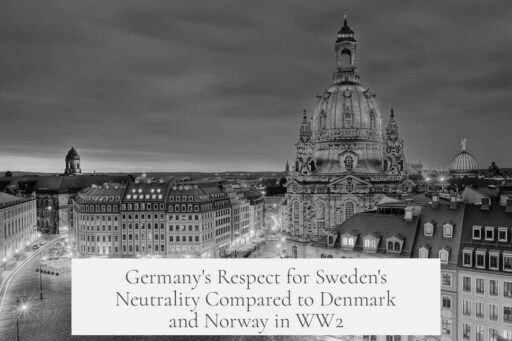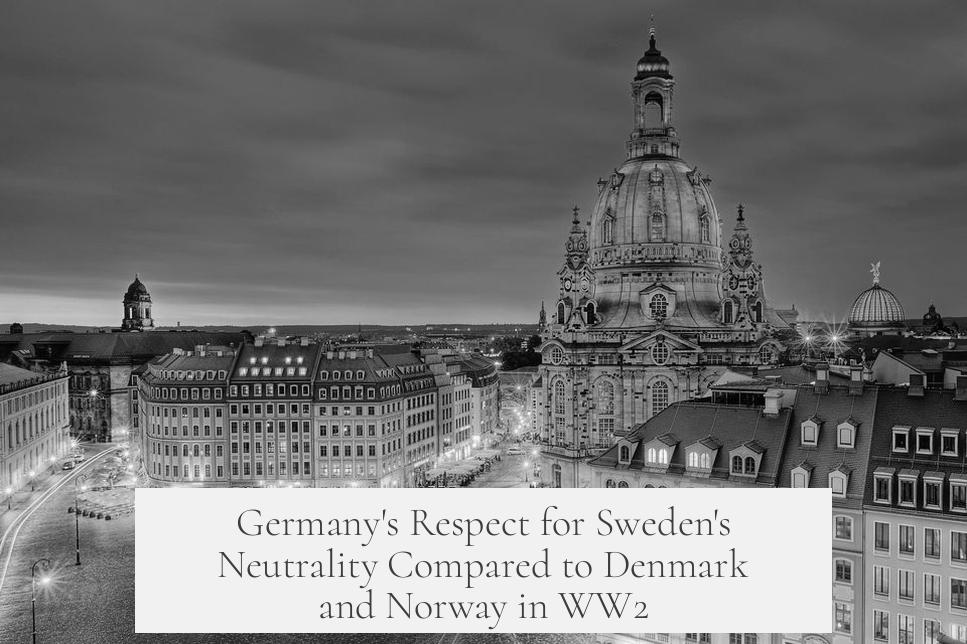Germany respected Sweden’s neutrality during World War II because Sweden maintained a strict neutral stance and supplied Germany with critical materials, while Denmark and Norway’s geographic and strategic positions made their control vital for German military operations.
Sweden had a long-standing policy of neutrality, lasting over a century before World War II. This consistent neutrality meant Sweden did not pose a military threat or side openly with the Allies. Furthermore, Sweden provided valuable resources like iron ore and tungsten, essential for German war industries manufacturing ammunition, tanks, and airplanes. Maintaining access to these materials through Swedish supply lines was vital for Germany’s war effort.
Sweden’s neutrality was mutually beneficial. Because Sweden did not join the Allies, it allowed Germany to focus troops elsewhere instead of occupying Sweden. Sweden also refused Allied requests to transport troops across its territory to aid Finland during the Soviet invasion, reinforcing its neutral position.
Moreover, Sweden negotiated assurances for continued ore exports to Germany after Denmark and Norway were invaded. This stable trade relationship reinforced Germany’s incentive to respect Swedish neutrality. The German leadership valued having a neutral neighbor for economic exchanges, diplomatic channels, and intelligence operations. Sweden’s neutrality enabled Germany to secure raw materials without the need to commit forces for occupation.
In contrast, Denmark and Norway held critical strategic positions that Germany could not ignore. Denmark bordered Germany directly and could serve as an Allied invasion route to Berlin or a base for bombing raids. Controlling Denmark secured safe passage through the Baltic Sea, protecting German naval and cargo movements.
Norway’s importance was largely tied to the transit of Swedish iron ore via the Norwegian port of Narvik. This seaway was crucial for ensuring the steady flow of raw materials from Sweden to Germany. Allied powers, primarily Britain, applied diplomatic pressure on Norway to stop these shipments, aiming to sever Germany’s access to these resources and to use Norwegian territory against Germany.
When Britain mined Norwegian territorial waters in April 1940 to disrupt German supply lines, it violated Norwegian neutrality, compelling Germany to act. Germany invaded Denmark and Norway the following day, citing the need to protect regional neutrality and secure supply routes. The German invasion was a strategic move to counter British incursions and to maintain control over Norway and Denmark’s strategic locations.
Germany justified invading Norway partly because British actions breached Norwegian neutrality first, not solely because Norway was neutral. This nuance underscored the complex geopolitical situation where neutrality was difficult to respect if one side violated it for strategic reasons.
| Country | Neutrality Status | German Policy | Strategic Importance | Outcome |
|---|---|---|---|---|
| Sweden | Strict Neutrality | Respected | Supplier of iron ore and tungsten | Maintained independence and trade |
| Denmark | Neutral Initially | Invaded and occupied | Border with Germany, Baltic Sea control | German occupation for security |
| Norway | Neutral Initially | Invaded and occupied | Access to Narvik port, control of sea routes | Occupied to secure supply lines |
Sweden’s ability to continue providing Germany with critical resources, coupled with its refusal to allow Allied troop passage, underscored its neutral stance and strategic value as a trade and diplomatic partner. Conversely, Denmark and Norway’s geographic locations made them targets for military occupation to secure supply routes and deny the Allies footholds near Germany.
The German occupation of Denmark and Norway allowed control over the Baltic and North Sea, securing maritime routes and protecting vital ore shipments from Sweden. Germany’s respect for Sweden’s neutrality relied on practical considerations: Sweden posed no immediate threat and was an essential economic partner, making occupation unnecessary and inefficient.
- Sweden’s long-standing neutrality and valuable resource exports encouraged German respect for its neutrality.
- Denmark’s proximity to Germany and control of the Baltic Sea made it strategically critical for occupation.
- Norway’s port of Narvik was essential for transporting Swedish ore, prompting German invasion following British attacks.
- British violations of Norwegian neutrality triggered Germany’s occupation of Norway and Denmark.
- Germany prioritized military and economic needs over diplomatic formalities with Denmark and Norway.
Why Did Germany Respect Sweden’s Neutrality but Not Denmark and Norway’s During WW2?

The simple answer is: Germany respected Sweden’s neutrality because it suited their strategic needs, but Denmark and Norway’s locations and circumstances made neutrality a luxury Germany wasn’t willing to honor. Let’s dive deeper into this fascinating slice of WWII history and unpack why this geopolitical puzzle unfolded the way it did.
First, Sweden’s neutrality wasn’t a whim. It was a well-established policy stretching over a century. By the time WWII rolled around, Sweden had carefully cultivated its stance of non-intervention in conflicts. Countries like Norway, the Netherlands, and Belgium also tried to be neutral. However, history shows us neutrality sometimes gets tested, as with Belgium during WWI.
So, why did Germany tiptoe respectfully around Sweden’s neutrality? Because Sweden was incredibly valuable in its neutral role. It provided essential resources to the Germans—especially iron ore and tungsten, critical materials for producing tanks, ammunition, and airplanes. Germany needed those raw materials flowing continuously to fuel its war machine. It also needed to avoid an unnecessary second front in Scandinavia by invading a neighbor that wasn’t threatening its ambitions.
Sweden, unlike Denmark and Norway, also refused Allied requests to allow troops to transit its lands to aid Finland against the Soviet invasion. This demonstrated a genuine intent to stay neutral early in the war. The Swedish government cleverly used the significance of its ore exports as leverage to negotiate its ongoing neutrality even after Germany’s invasion of Norway and Denmark.
Now, let’s talk about Denmark and Norway. These two countries had unfortunate geographic lots in life. Denmark lies right on Germany’s border. If Denmark joined the Allies, it would give them a perfect launching pad to bomb or even invade Berlin. That’s basically like lending your enemy a battering ram. Not ideal.
Norway’s geographical significance was just as crucial. The Swedish iron ore often reached Germany via the Norwegian port of Narvik, which made Norway a critical transit point. Controlling Norway meant the Germans could secure these shipments and protect supply lines. Losing Norway meant risking the traffic in vital resources being cut off or preyed upon by Allied naval forces.
But why didn’t Germany just respect Norway and Denmark’s neutrality like Sweden’s? Because neutral didn’t mean safe for those two. British actions broke Norwegian neutrality first by mining its territorial waters in April 1940. This British move was designed to disrupt German supply routes and to attempt to pull Norway out of neutrality and possibly bring in troops to help Finland.
Germany used the British breach as “justification” for its own invasions of Denmark and Norway the very next day. This invasion aimed to secure the region, ensure safe passage in the Baltic Sea, and most importantly, protect the iron ore shipments essential for the Nazi war effort.
Strategically, having Denmark and Norway under occupation allowed Germany to shield its northern flank. Also, controlling Denmark meant much-improved security for German naval traffic in the Baltic Sea, which was vital for moving men, machines, and materials.
Meanwhile, the Germans could leave Sweden alone and rely on its cooperation. Sweden’s strictly neutral policy guaranteed uninterrupted flow of resources, trade, and some level of diplomatic cooperation. Plus, having a neutral neighbor in the north wasn’t just convenient; it was smart for spy missions and intelligence gathering behind enemy lines.
Think about it: Germany needed to weigh the costs of invading Sweden—potentially stirring up more trouble—against the benefits of keeping a reliable neutral supplier at their side. Invading Sweden might have forced Allies to focus on Scandinavia more intensively, something Germany wanted to avoid while juggling fronts in Poland, France, and later the Soviet Union.
In summary, Germany’s respectful nod to Swedish neutrality was practical, calculated, and highly beneficial. Denmark and Norway weren’t lucky enough geographically or strategically to deserve the same treatment. The shifting tides of war, resource logistics, and naval control dictated that respect for neutrality wasn’t a one-size-fits-all rule during WWII.
Final Thoughts: Could Sweden Have Been Invaded?
Could Germany have invaded Sweden? Sure. But why waste troops and resources on a friendly, cooperative neighbor when you could grab two much more strategic countries quickly? Instead, Germany chose to keep Sweden neutral, ensuring a steady flow of materials and a quiet northern border. It’s a classic example of war pragmatism over idealism.
Does this story teach us anything? Absolutely. Neutrality in wartime depends not only on a country’s intentions but also on geography, resources, and the broader chessboard of global strategies. Sweden’s neutrality thrived because it was useful and respected, while Denmark and Norway’s neutrality was sacrificed due to the brutal necessities of war.
Next time you hear about neutrality, remember: in war, it’s as much about location and resources as it is about good intentions.




